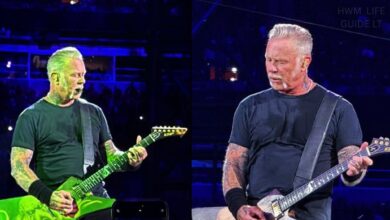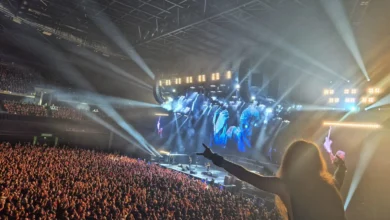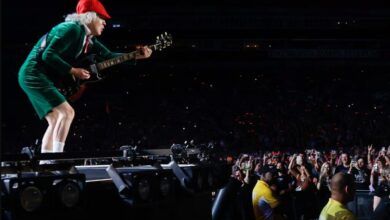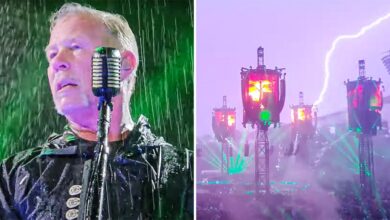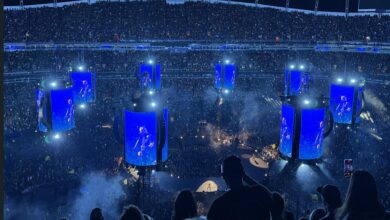Iron Maiden Unleash “Powerslave” Amid Their Most Stunning Stage Visuals Ever in Glasgow 2025
The atmosphere inside OVO Hydro in Glasgow on June 30, 2025, reached fever pitch as Iron Maiden launched into “Powerslave.” The unmistakable Egyptian-flavored riff washed over the crowd, igniting cheers that echoed off the walls. Fans wearing replica stage attire from the original 1984 “Powerslave” tour looked on in awe, as if they’d been transported through time to relive Maiden’s iconic heyday in full force.
Bruce Dickinson commanded the spotlight, delivering the lyrics with fierce precision while projecting theatrical flair across the venue. His commanding voice propelled the narrative of ancient pharaohs and cursed eternal life, making the audience feel like they were walking through the Valley of the Kings. That sublime blend of storytelling and raw power remains a signature of Maiden’s grand live spectacles.
The three-guitar attack—Dave Murray, Adrian Smith, and Janick Gers—wove intricate harmonies, their synchronized solos shining bright during the song’s extended sections. Their chemistry moved beyond mere performance; it felt like a live history lesson in guitar craftsmanship. The calculated interplay between them brought a modern sheen to a classic, affirming their enduring musical bond.
Steve Harris anchored the performance with galloping bass intensity, the track’s backbone pulsating like a rhythmic heartbeat throughout the hall. His dynamic movement and headbanging added visual drama, while his bass lines drove the song through dizzying crescendos. Harris’s mastery of “Powerslave” bass parts remains a testament to why he’s viewed as one of heavy metal’s foundational figures.
Simon Dawson, Maiden’s new drummer, took on Nicko McBrain’s intricate fills and shifting tempos with impressive finesse. His thunderous rolls during the song’s breakdowns resonated through the venue, proving he’s not a replacement—he’s a force in his own right. Dawson’s confident presence ensured the percussion pulse remained solid, providing a fresh yet familiar beat to the classic track.
The stage visuals stole the show: towering LED screens projected colossal Egyptian monuments and hieroglyphs, immersing the audience in the song’s mythic setting. Golden sands and burning sun motifs moved behind the band in glorious sweep, enhancing the immersive feel. Ian McMurtrie’s cinematic design elevated the track beyond music into theatrical experience.
Mid-song, the tempo slowed, and the lights dimmed, letting the dramatic Egyptian ambiance dominate. The sudden shift into atmospheric near-silence before the guitar burst left fans collectively breathless. This dynamic contrast highlighted Maiden’s unmatched understanding of pacing—balancing bombast with sensitive storytelling.
Adrian Smith’s melodic solo soared above the ambiance, first cautious and thoughtful, then raging into a triumphant call to arms. His phrasing echoed earlier solos from the 1984 tour but with a grown sophistication that reflected decades of refinement. The moment felt like the past and present colliding in a musical spark.
Throughout the song, the audience sang along with passion, their voices mirroring Dickinson’s during choruses. That sea of joined voices created a communal chant that reverberated through the space. It became clear Nurturing shared participation lies at the heart of Maiden’s power—a ritualistic union of band and fan.
Between verses, Maurice strolling between cables and amps, Dickinson raised his arms, waving them like a conductor leading an orchestra of enthusiastic metalheads. His interaction was genuine, unforced—no rock-star camouflaging, just heartfelt acknowledgment of the moment’s grandeur. Those real connections made the performance sharply human amid the larger-than-life spectacle.
When the final sustained note rang out, a wave of applause and deafening cheers erupted. The ending wasn’t tidy—it was seismic, like thunder rolling over ancient sand, leaving the audience in reverent awe. Maiden achieved something rare: a perfectly crafted end to an epic chapter in the evening’s musical journey.
As “Powerslave” segued into the next track, the crowd remained energised, feeding off the charged air that the performance had unleashed. The force of this classic song propelled the rest of the set with renewed intensity, setting the stage for what would become a legendary night.
After the show, social media lit up with shared fan reflections. Clips of the performance flooded platforms like TikTok and YouTube, with fans marveling at how “Powerslave” had transcended nostalgia to become a monumental live triumph. Comments praised both the visuals and musicianship as Maiden at their grandest.
Glasgow’s “Powerslave” wasn’t just a single-song highlight—it epitomized the essence of the Run For Your Lives tour: a celebration of Iron Maiden’s early catalog, executed with precision, passion, and flair. The performance reaffirmed that even classic-era songs continue to flourish when handled with devotion and spectacle.
For fans who have followed Maiden since the vinyl days, the moment carried emotional weight. But even newcomers recognized its potency. The fusion of historical homage, technical brilliance, and raw emotion on “Powerslave” affirmed Iron Maiden’s ability to make every note resonate anew, live onstage in 2025.
